To Autumn1 |
|
Season of mists and mellow fruitfulnessMaturing fruits. Autumn is the season for harvesting crops.
 Pears are harvested in the fall.,
2
Pears are harvested in the fall.,
2
Close bosom-friendAutumn relies on the sun, in this case for producing fruit. of the maturing sunThe sun of autumn that gives nutrients to the fruits, making them "mature" or ripen. The sun is also progressing through the year, and thus "maturing" in its annual cycle.;
ConspiringWorking together. Literally "to breathe together." Hirst sees this as Ceres and Apollo plotting together to "murder" the fruit and grain which are now ripe.3
with him how to load and blessReferencing the fruit. "Load and bless" would be a good harvest of crops.
With fruitThe sounds made as this line is read mimic the twisting motions of the vines as they creep along the wall and roof (Hirst 151). the vines that roundVines full of fruit are covering the roof., the thatch-evesEaves are the edges of a roof which overhang the face of a wall and project beyond the side of the building. Here the roof is thatched (another use for the ripened products of the fields). Keats' spelling of the word, however, calls to mind the inevitable progression of the day to evening.
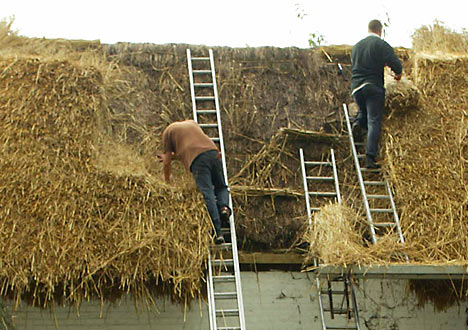 A roof being rethatched by two Master Thatchers. run;
A roof being rethatched by two Master Thatchers. run;
To bend with applesRicks notes the downward movement of the vines and branches, and connects this with the inward pressure of the fruit ripening "to the core."
 An apple tree laden with fruit in the fall. the moss'dCovered in moss, which can also show maturity and age.
An apple tree laden with fruit in the fall. the moss'dCovered in moss, which can also show maturity and age.
 An orchard of mossy trees. cottage-trees,
An orchard of mossy trees. cottage-trees,
And fill all fruit with ripeness to the core;
To swell the gourdTo make gourds, like pumpkins and squash, grow even larger from so much nutrients, making them overripe. Gourds are also typically associated with the fall season.
 A pumpkin that has overripened from being on the vine too long., and plump the hazel shellsThe nuts also overripen from nutrients. Overripe food cannot be sold or eaten, so this shows excess.
A pumpkin that has overripened from being on the vine too long., and plump the hazel shellsThe nuts also overripen from nutrients. Overripe food cannot be sold or eaten, so this shows excess.
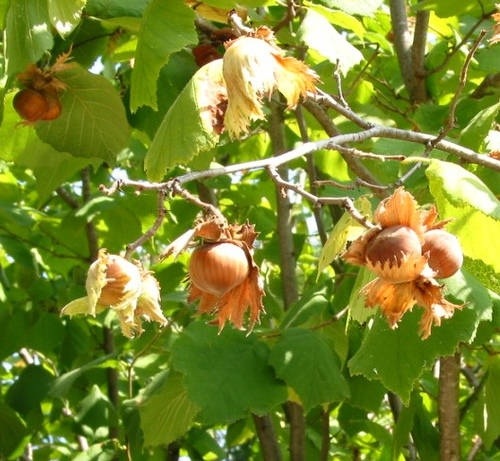 These are hazelnuts that are at peak ripeness. When overripe, they become heavy and fall from the branches.
These are hazelnuts that are at peak ripeness. When overripe, they become heavy and fall from the branches.
With a sweet kernelA seed, referring to growth in the future. This shows how cyclical life is, through growing food.; to set budding more,
And still moreThe repetition of more shows excess.,4 later flowers for the bees,
Until5
they think warm days will never ceaseDramatic irony is used by Keats to refer to his own mortality. "Warm days" here means life.,
For summer has o'er-brimm'dOver filled. their clammy cells.The overfilled cells of a beehive. The use of "clammy" gives the sense of unpleasantness from being overfilled. The overabundance of honey from summer shows how good the seasons of spring and summer were for the bees, which are the prime times of their lives.
 How the inside of bee hives look. They create the hexagonal cells to hold the honey.6
How the inside of bee hives look. They create the hexagonal cells to hold the honey.6
Who hath not seen thee7
oft amid thy storeAn abundance, talking about autumn's harvest.?
Sometimes whoever seeks abroad may find
Thee sitting carelessBeing lethargic or lazy.8
on a granary floorA storage house for grains that have been threshed, or beaten to be separated from the plant.
 A room where grain could be stored once it is harvested.,
A room where grain could be stored once it is harvested.,
Thy hair soft-liftedGently lifted. This line makes autumn sound feminine. by the winnowingA method of separating chaff from grain by using strong winds created by hand-held fans.
 A winnowing fan, used to separate wheat from chaff. windThe onomatopoeia of "winnowing wind" alludes to the musicality of the third stanza. Keats uses it here to connect the second, primarily visual stanza to the third, primarily musical stanza, like a literary bridge. (Hirst 151),
9
A winnowing fan, used to separate wheat from chaff. windThe onomatopoeia of "winnowing wind" alludes to the musicality of the third stanza. Keats uses it here to connect the second, primarily visual stanza to the third, primarily musical stanza, like a literary bridge. (Hirst 151),
9
Or on a half-reap'dHalf finished. furrowThe long, small valleys in fields that are between crop rows.
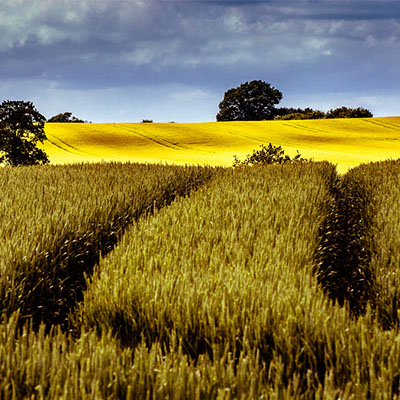 A field with furrows between the rows of crops. sound asleepAgain, the idea of lethargy.,
A field with furrows between the rows of crops. sound asleepAgain, the idea of lethargy.,
Drows'd with the fume of poppiesPoppies create an opiate that makes a person peaceful and numb. About three months after poppy seeds are planted, brightly-colored flowers bloom at the tips of greenish, tubular stems. As the petals fall away, they expose an egg-shaped seed pod. Inside the pod is an opaque, milky sap. This is opium in its crudest form. Keats could be using it in reference to the peace and numbness of death.
 Poppies can grow amongst grain in fields, like these poppies in a rye field., while thy hookA scythe, used for crops. This is also the weapon carried by death.
Poppies can grow amongst grain in fields, like these poppies in a rye field., while thy hookA scythe, used for crops. This is also the weapon carried by death.
 "The Veteran in a New Field" by Winslow Homer, 1865.
"The Veteran in a New Field" by Winslow Homer, 1865.
The figure is cutting a swath.
Spares the next swathThe path cut by a scythe hook. This path is spared so it is left unscathed. and all its twinedIntertwined. The flowers are growing among the crop so they are intertwined. flowers:
And sometimes like a gleanerCleans what reapers have left behind. While there is now a machine for this, in Keats' time people had to trail behind those cutting the crop to pick up what was left.
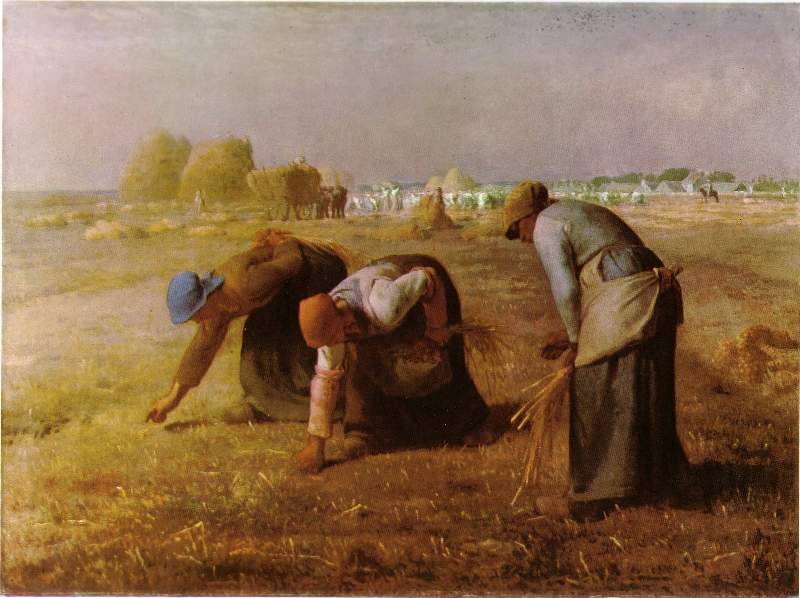 "The Gleaners" by Jean-François Millet, 1857. thou dost keep
"The Gleaners" by Jean-François Millet, 1857. thou dost keep
Steady thy laden headBalancing a load, most likely more crops, on your head while crossing a stream.
 "The Gleaner" by William Morris Hunt, 1865. across a brook;
"The Gleaner" by William Morris Hunt, 1865. across a brook;
Or by a cyder-pressA machine that squeezes apples to make apple cider.
 Two men making cider around the early 1800s., with patient look,
Two men making cider around the early 1800s., with patient look,
Thou watchest the last oozingsLiterally the last drops of juice and pulp from the pressed apples. This also gives a Gothic vision of the last bits of life leaving the body, like the juice leaving the apple. "Ooze" is considered onomatopoetic because the sound of the word mimics its definition. hours by hours.The repetition of hours makes the reader think about the passing of time.10
Where are the songs of spring?Songs of growth and life, which are absent in Autumn. Ay, Where are they?
Think not of them, thou hast thy music too,—11
While barred cloudsClouds that appear in straight lines across the sky.
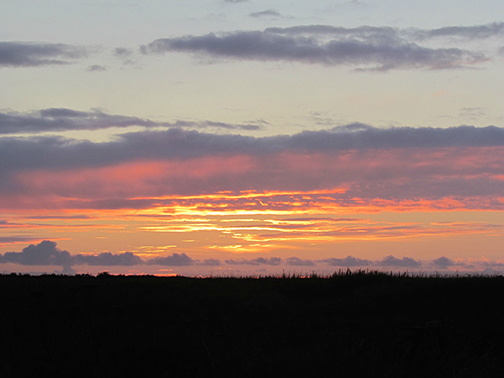 Barred clouds at sunset. bloom the soft-dying dayThe day ending. Autumn can also represent the end of the growing cycle, when everything is harvested. It can also represent the end of life.
Barred clouds at sunset. bloom the soft-dying dayThe day ending. Autumn can also represent the end of the growing cycle, when everything is harvested. It can also represent the end of life.
 The day ending.,
The day ending.,
And touch the stubble-plainsThe fields that have been cut short to harvest the grains now look stubbly, or prickly.
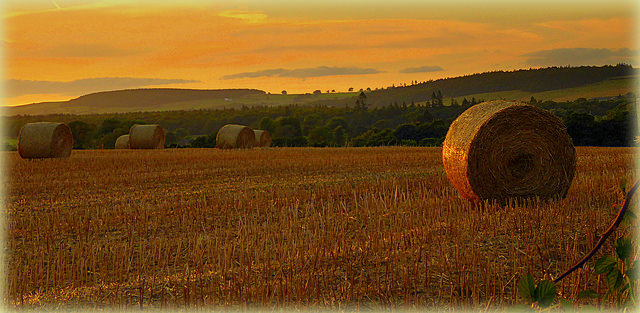 A field that has been harvested and washed in light from the setting sun. with rosy hueA pink glow given by a setting sun.;
A field that has been harvested and washed in light from the setting sun. with rosy hueA pink glow given by a setting sun.;
Then in a wailful choirA mourning choir, as would be associated with a funeral. the small gnats mournSadness stemming from loss. The gnats mourn for the end of the season and the loss of their source of food, the overripe fruits.
Among the river sallowsWillow trees.
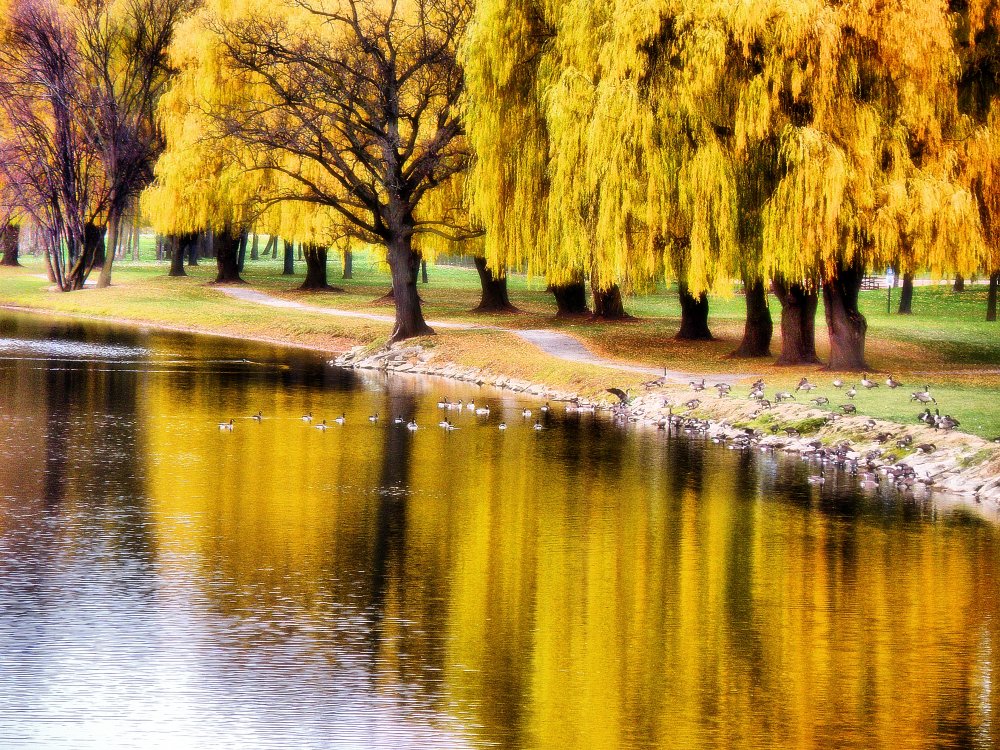 Autumn willow trees by a river., borne aloft
Autumn willow trees by a river., borne aloft
Or sinking as the light wind lives or dies;
And full-grown lambsLambs are never fully grown; they either become sheep for shearing or are slaughtered. The "spring lambs" that were not slaughtered during that season have now reached a size where they can be either cultivated for wool or slaughtered for meat. The term "full-grown lambs" is an oxymoron, offering two opposing ideas. Keats uses clashing terms to again remind the reader that Autumn is itself a clash of opposites: it both ripens and reaps, and is the clash of Summer and Winter in weather, nature, feelings, and the life cycle.
 Two lambs and a sheep. loud bleatA "death call" from the full-grown lambs. Lambs and sheep are some of the only animals that change the timbre of their call to show distress. from hilly bourn;
Two lambs and a sheep. loud bleatA "death call" from the full-grown lambs. Lambs and sheep are some of the only animals that change the timbre of their call to show distress. from hilly bourn;
Hedge-crickets singCrickets chirp by rubbing their forewings together. Here they inhabit the hedge-rows, closely spaced shrubs or trees that are planted and trained to form a barrier or to mark the boundary of cultivated or inhabited area. So they live on the border between the world untouched by humans and the world humans have bent to their will.
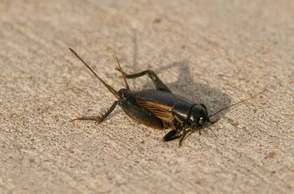 A field cricket.; and now with treble softA treble sound is high-pitched. In choral music, the trebles are usually boy sopranos. The robin here is the soprano soloist, singing with the gnat choir. The bird sings softly; there is no urgency or fear in its calls. "Treble" is also a term for three, which refers back to Autumn, the third season.
A field cricket.; and now with treble softA treble sound is high-pitched. In choral music, the trebles are usually boy sopranos. The robin here is the soprano soloist, singing with the gnat choir. The bird sings softly; there is no urgency or fear in its calls. "Treble" is also a term for three, which refers back to Autumn, the third season.
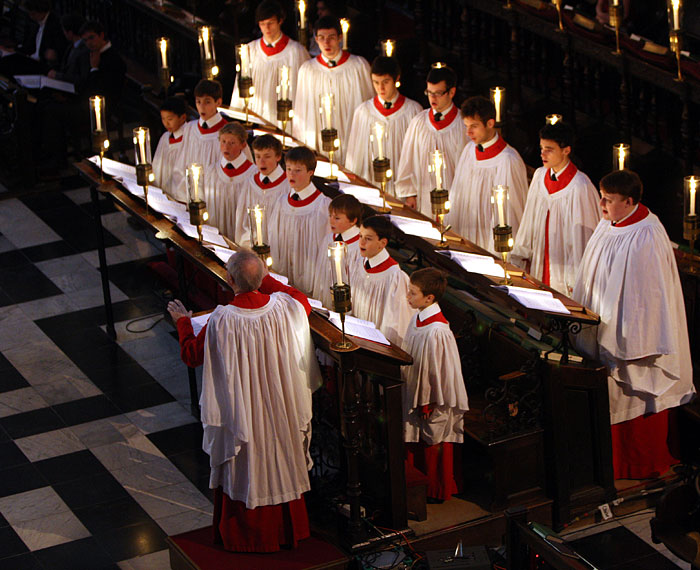 Traditional cathedral choirs wear red cassocks, so the robin's red breast recalls this.
Traditional cathedral choirs wear red cassocks, so the robin's red breast recalls this.
The red-breastUnlike in the US, where the robin is a herald of Spring, the English red-breasted robin is a winter bird. Keats uses the robin to hint at the coming winter as the Autumn poem—and Autumn— comes to an end.
 An English red-breasted robin.12
whistles from a garden-croftAn enclosed garden or a small piece of land.
An English red-breasted robin.12
whistles from a garden-croftAn enclosed garden or a small piece of land.
 A closed off garden.;
A closed off garden.;
And gatheringThis descriptor also reminds the reader of other things that gather: storm clouds and darkness. The swallows are banding together for their long migration to a warmer climate. swallowsMournful gnats and crickets are what attract the swallows. They are migratory birds that only stay to feast on the insects.
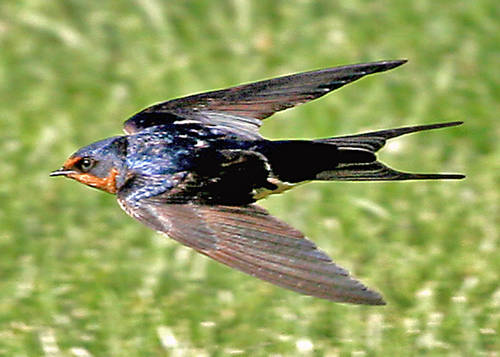 The swallow has a distinctive silhouette when flying because of its pointed tail feathers. twitterBird calls. in the skiesThe swallows are flying above.
The swallow has a distinctive silhouette when flying because of its pointed tail feathers. twitterBird calls. in the skiesThe swallows are flying above.
 Silhouettes of swallows..
Silhouettes of swallows..
Notes
1. Composed on 19 September 1819 and published in 1820, "To Autumn" is the final "1819" ode. Keats composed "To Autumn" after a walk near Winchester one autumnal evening; he described his experience in a letter to his friend Reynolds:
How beautiful the season is now--How fine the air. A temperate sharpness about it. Really, without joking, chaste weather--Dian skies--I never lik'd stubble fields so much as now--Aye better than the chilly green of the spring. Somehow a stubble plain looks warm--in the same way that some pictures look warm--this struck me so much in my Sunday's walk that I composed upon it.
[Letter written September 22, 1819, from Winchester]
A little over a year following the publication of "To Autumn", Keats died in Rome.
Harold Bloom calls "To Autumn" "one of the subtlest and most beautiful of all Keats's odes, and as close to perfect as any shorter poem in the English Language" (Bloom 421-22).
In contrast, Allen Tate writes, "'To Autumn' is a very nearly perfect piece of style but it has little to say" (Vendler 13).
Annabel Patterson calls "To Autumn," "Its place in Keats's mythic career has given it status as a finale" (Hirst 150-151).
2. There is no narrative voice or persona at all. A persona is a fictional character; sometimes the term means the mask or alter-ego of the author. It is often used for first person works and lyric poems to distinguish the writer of the work from the character in the work. However, Keats writes the ode from his own voice.
3. In the first two and a half lines, the sun and autumn conspire. This shows the close working relationship and intention.
4. From lines 3 to 9, Keats uses parallelism to construct images: "to load and bless," "To bend...and fill," "To swell...and plump," and "to set...And still more."
5. In the last two lines of the stanza, Keats begins the phrase with "until," a subordinating conjunction. This means the last two lines are a subordinate clause, also called a dependent clause. Structurally, the subordinate or dependent clause is appropriate because the overflowing production of honey is contingent—or dependent— on the seemingly unending supply of flowers from Spring and Summer.
6. The first stanza is punctuated as one sentence; clearly it is one unit. However, it is not a full sentence because it lacks a verb. Keats purposely omits any verb to keep the focus the stanza on the details of ripening.
7. Autumn becomes personified as "thee."
8. By stanza II, all movement has stopped as any growth ends.
9. In 1737, a family in Scotland developed a machine for winnowing corn. This "Fanner" was seen as a sin against God because He is the one who creates wind; ministers felt the power of creating wind should solely belong to God. The importance of the natural winnowing wind should be considered when addressing a poem steeped in nature.
10. The last line emphasizes the slowing of time, using "oozing" and the repetition of "hours" to slow the reader.
Hirst describes stanza II as four frames of images, paused in time. The description lends itself to seeing each scene as a tableau, coming together as visuals for Autumn.
11. Bloom says Keats reminds the readers of the songs of Spring to contrast the sounds given below. For example, in Spring, lambs calls are lower and more mellow. When they are grown in the Autumn, their distressed bleat is much higher.
12. Gilbert White calls European robins (not to be confused with the American robin) "Autumn songsters." Their voices are lost in the chorus of spring but they stick around in winter and their song stands alone; they are the solitary tone of autumn (January 1879 Gilbert White).